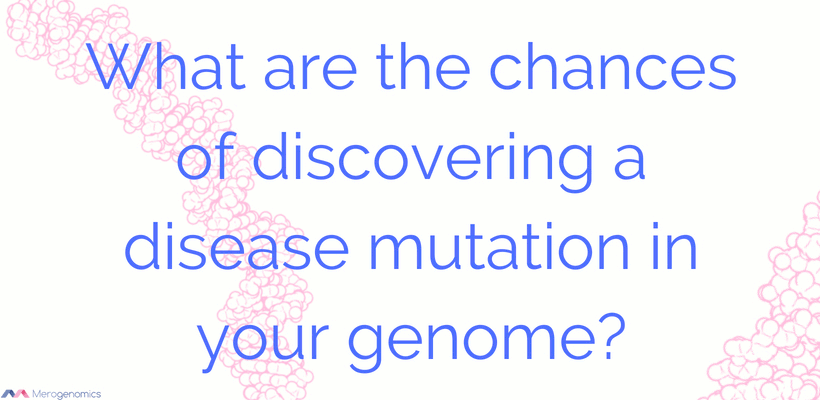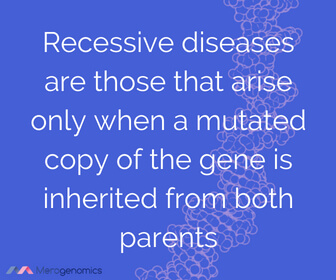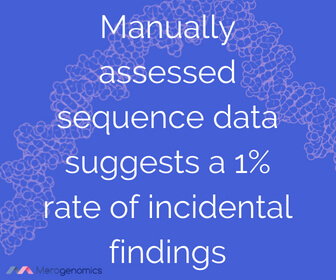
Superhero versus disease genetics – what are your odds?
Dr.M.Raszek
Disease mutations lurking among us
One major question one could (or should?), be asking themselves is, “what are the odds that if I sequence my genome I will find a health risk result?” Or in other words, a result that shows that a person harbours a pathogenic variant that is indicative of disease development.
This is still a huge source of contention, and science is continuously pouring in to determine what mutations can truly be associated with disease, as well as how frequently such incidental findings about a threat to your health actually do occur in a population. As more humans have their genomes or exomes (the portion of the genome that codes for proteins only), sequenced, some repetitive patterns begin to emerge. As this is such an important area of concern and one of the most significant topics to evaluate if considering sequencing your own genome, let’s take a look at some published data.
One of the bigger and earlier studies on the subject was published in 2015, as it involved sequenced exomes of 11,068 individuals . Again, that is the sequencing of only the genes in your genome, which, when broken, account for the majority of human diseases (at our current level of understanding of genome function). Now, this was not a heterogenous population that you would typically find on the street though: 77% were people aged 45-64 years studied for atherosclerosis risk, and the remainder were individuals admitted to the Baylor Hopkins Center for Mendelian Genomics to look for novel Mendelian diseases genes (those diseases you inherit and are typically caused by a single gene). So these results could be somewhat skewed.
This study was intriguing because of the list of genes involved in recessive diseases that was compiled, numbering in total 1,423 genes associated with 1,493 disorders. That is quite a large dataset! Recessive diseases are those that arise only when a mutated copy of the gene is inherited from both parents. Inheritance of just one mutant copy from either mom or dad is typically not good enough to contribute to disease development, because the good copy inherited from the other parent makes up for the deficit.
Typically the list that is assessed is much shorter, based on the guidelines published by the American College of Medical Genetics and Genomics as the canonical list of 56 genes that need to be investigated for incidental finding when genome or exome sequencing is performed in a clinical setting. That is because all of the genes on that list are involved in either childhood or adult disease development for which either treatment or clinical intervention is available. Since its publication, this is considered the gold standard (and since has been expanded to a list of 59 actionable genes). Thus, these genes are typically the first ones to be investigated.
So what did they find? Just from assessing the gold standard ACMG list of 56 genes amongst all the different ethnicities investigated, the incidental findings ranged between 5-6%, which seems quite high. These results were based on a comparison with previously reported data in a conservative database of clinical pathogenic variants. While no database is without errors, one has to wonder what could be the actual amount of incidental findings if it could also include the mutations that have not yet been discovered and have never yet been reported? Or if entire genomes could have been investigated? We will cover the answer to this question in the next blog in this two part series.
Automation is our future
Of course novel mutations are found all the time and reported; that is how these databases of knowledge are generated. But it is not an easy process to be able to definitively determine what a new causative mutation of disease is, as it usually takes an entire team of specialists to manually analyze the data. This is one of the major complications that are being encountered with data interpretation, and is a problem with many of the reported genetic tests available directly to consumers (no medical oversight required), as they often use unverified claims to provide the results of such tests. Luckily, such tests are almost never of medical significance (and the FDA is quite strict in ensuring this).
Due to the amount of data obtained when sequencing a human genome or exome, manual investigation of the discovered variants is simply not practical. While done many times for scientific research purposes, the future of genome sequencing will rely on complete automation. This will also include attempts at predicting potentially novel pathogenic variants. But at the moment, this part of progress is still going slowly. The authors of this publication used an algorithm that was shown to be one of the best performing ones, but still had a horrendous 57% false-positive rate. Therefore, our understanding of how mutation might be damaging to the proper biological function of a protein still needs a lot more improvement.
Nevertheless, the authors tried it, and considered it an extreme limit of possibility, as the resulting numbers truly seemed wild. First of all, if looking at any mutation, known or unknown, only about 14% of the population showed no mutation whatsoever in these 56 genes. That is really astonishing, because it means that for the majority of us something in these 56 actionable disease genes would be found, and then the question would be: is it a serious mutation to worry about or a benign alteration? Although keep in mind that we were dealing with here was a population that was hospitalized.
When these mutations were investigated by software, 51% of the population was found to have predicted potentially harmful mutations in these genes. While some of these mutations might turn out to be truly health-threatening, if these numbers crunched by the predictive software were accurate, we would be bumping into people with diseases left and right, and half of us would be hospitalized. I guess for now we will have to stick to the previously observed finding of 5-6% of previously known disease mutations. This demonstrates how complex the interpretation of a sequenced human genome can be.
Is anyone genetically healthy?
What about the other 1,423 genes of autosomal recessive disorders (autosomal meaning, chromosomes other than the X and Y sex chromosomes, and recessive meaning the same mutant gene from both parents would have to be inherited for a disease to develop)? Well, here the numbers were also fascinating, as everyone carries some mutation in these genes. 51% of everyone tested carried at least one mutation that had previously already been observed as pathogenic, with an average of 0.78 pathogenic mutation per individual in the entire population. Being a carrier of a recessive mutation does not mean you will have a disease, as it takes both copies of the gene you inherited from each of your parents to be mutated in order to develop a recessive disease.
Based upon these observations, and assuming a random pairing between the people in the studied dataset, the authors predicted that 0.5% of couples expecting children will be carriers of mutations in the same disease gene. This they compared to the less than 1.2% that could be expected based on estimated monogenic autosomal recessive diseases observed in the population. That is if we randomly pair people together, suggesting no relationship between individuals, which may not always be the case. So there you have it: a 0.5-1% reason why you should look into your genes with your partner if you plan to have kids.
But as I mentioned previously, the 5-6% rate of pathogenic incidental findings seems high. So for the sake of balance, I will bring up just one more study. This study was published a few months after the previously discussed paper. In this research, 1,092 individuals who had both their genomes and exomes sequenced were analyzed for the probability of incidental findings. While this study actually had far fewer participants, the reason why this is of interest is that the results were manually curated, meaning some smart blokes actually individually looked through the potentially pathogenic variants to determine if they passed the mark or not. As they used more stringent criteria, their result was 1% rate of incidental findings. What is tragic though, and also commented on by the authors, is that this work was done with unidentified samples, and therefore there was no way of actually informing any of the individuals who contributed to the study of these potentially life-saving discoveries.
Time will tell where on the spectrum of actionable variant discovery amongst the population we truly lie. It is probably somewhere between these two values here mentioned. However, just because a pathogenic result is found does not mean a person is bound to get that particular disease. Diseases have varying degrees of expression that are influenced by a multitude of internal and external factors – this is referred to as penetrance. Thus a person with a disease can exhibit a whole spectrum of symptoms, ranging from very mild to very severe.
Superhero protective genes
While there can be many influencing factors, additional genetic effects are also likely to play a role. Such accompanying impacts of other genes are referred to as being “epistatic”. This is one of the dramatic advantages of sequencing the whole genome, as it allows for future reanalysis and an additional understanding of how the different variants might be influencing the whole picture.
It turns out that even if you have a mutation that is expected to lead to a disease, some rare individuals, for reasons unknown, do not develop a disease. They are like a genetic version of super-humans.
In a study released in 2016, an astounding 589,306 genomes were analyzed, including 518,721 genotyping data sets and 70,585 whole exome or whole genome sequencing data sets from 12 different studies around the world. These authors, including Dr. Rong Chen, have a knack at looking at impressively large genetic data sets. And guess where their biggest data set came from? The 23andMe commercial test accounted for nearly 70% of the data! Power in numbers! Amazingly, the authors discovered 13 individuals with mutations in 8 genes for highly penetrable severe Mendelian diseases but who showed no clinical symptoms at all. I can just imagine how they felt when they found the first one after searching roughly 50,000 data sets! That is like searching for those gold nuggets in a river stream! The authors commented on the possibility that the penetrance in this case might be in fact more complex than previously expected, and that such studies should be undertaken to seek potential “protective” variants against severe diseases. Very powerful stuff is already surfacing, and you can just imagine how this might play out one day in impacting medical treatment. In the future, not only will you be checking your partner’s genes for harmful mutations, you will also be checking for superhero mutations!
The bottom line is that at least 1-2% of the individuals who choose to investigate their genomes can expect to find actionable serious pathogenic variants. This number is bound to rise in the future as our understanding of the genetic contribution to disease continuous to expand. In addition, each individual can expect to carry some variants that could have an impact on their offspring if matched with a partner that carries a similar mutation in the same gene. Your chance of that happening appears to be between 0.5-1% if randomly partnered. Once that occurs, there is a one in four chance that your child will develop the disease. Of course, one can argue how random love partnering is, but that is too scientific even for this blogger!
And a final word of advice: don’t count on being one of those super-humans as 13 out of 589,306 is not too common! For all the rest, if you are seeking genomic investigation of your DNA, we can always point you in the right direction to what we consider to be the best medical genome sequencing test in the world.
This article has been produced by Merogenomics Inc. and edited by Kerri Bryant. Reproduction and reuse of any portion of this content requires Merogenomics Inc. permission and source acknowledgment. It is your responsibility to obtain additional permissions from the third party owners that might be cited by Merogenomics Inc. Merogenomics Inc. disclaims any responsibility for any use you make of content owned by third parties without their permission.
Products and Services Promoted by Merogenomics Inc.
Select target group for DNA testing
Healthy screening |
Undiagnosed diseases |
Cancer |
Prenatal |
Or select popular DNA test
 |
 |
 |
 |
Pharmaco-genetic gene panel |
Non-invasive prenatal screening |
Cancer predisposition gene panel |
Full genome |











